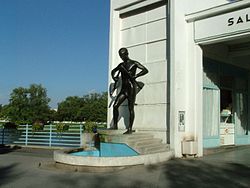Balneotherapy
| Balneotherapy | |
|---|---|
 Roman Baths in Bath Spa, England July 2006 | |
| MeSH | D001452 |
| This article is part of |
Balneotherapy (
are also widely used, a practice known as 'fangotherapy'.Definition and characteristics

"Balneotherapy" is the practice of immersing a subject in
Presumed effect on diseases

Balneotherapy may be recommended for various illnesses, including
Scientific studies into the effectiveness of balneotherapy do not show that balneotherapy is effective for treating rheumatoid arthritis.[7] There is also no evidence indicating a more effective type of bath,[7] or that bathing is more effective than exercise, relaxation therapy, or mudpacks.[7] Most of the studies on balneotherapy have methodological flaws and are not reliable.[8][7] A 2009 review of all published clinical evidence concluded that existing research is not sufficiently strong to draw firm conclusions about the efficacy of balneotherapy.[9]
"Balneophototherapy" combines salt bathing (balneotherapy) and exposure to
A 2018 systematic review concluded that "balneotherapy and spa therapy may be considered useful interventions for managing stress conditions".[11]
See also
- Boleslav Vladimirovich Likhterman
- Enoch Heinrich Kisch
- Destination spa
- Hot spring
- Hydrotherapy
- Mineral spa
- Onsen
- Peloid
- Thalassotherapy
References
- ISBN 978-0-19-920687-2.
- PMID 11623481. Retrieved 15 June 2022.
- ^ Chisholm 1911.
- S2CID 27602504.
- PMID 10731301.
- S2CID 40868870.
- ^ PMID 25862243.
- PMID 9330940.
- S2CID 26008531.
- PMID 32368795.)
{{cite journal}}: CS1 maint: multiple names: authors list (link - ^ Antonelli, Michelle; Donelli, David (2018). "Effects of balneotherapy and spa therapy on levels of cortisol as a stress biomarker: a systematic review". International Journal of Biometeorology. 62 (6).
Further reading
- Nathaniel Altman, Healing springs: the ultimate guide to taking the waters : from hidden springs to the world's greatest spas. ISBN 0-89281-836-0
- James Crook, The Mineral Waters of the United States and their Therapeutic Uses, Lea Brothers & Co., New York and Philadelphia, 1899.
- Dian Dincin Buchman, The complete book of water healing. 2nd ed., ISBN 0-658-01378-5
- Jane Crebbin-Bailey, John W. Harcup, ISBN 1-86152-917-1
- Chisholm, Hugh, ed. (1911). . Encyclopædia Britannica. Vol. 3 (11th ed.). Cambridge University Press. pp. 284–285.
- Esti Dvorjetski, Leisure, pleasure, and healing: spa culture and medicine in ancient eastern Mediterranean., ISBN 90-04-15681-X
- Carola Koenig, Specialized Hydro-, Balneo-and Medicinal Bath Therapy. Publisher: ISBN 0-595-36508-6
- Anne Williams, Spa bodywork: a guide for massage therapists. ISBN 0-7817-5578-6
